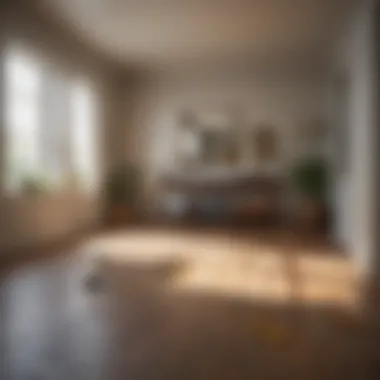An Expert Guide to Measuring Square Footage in Your Home


Intro
Measuring square footage in a home is an important task that goes beyond just assessing property size. Accurate measurements impact property valuation, interior design, and even real estate transactions. Whether you are a homeowner looking to sell, a buyer searching for the perfect home, or an interior design enthusiast wanting to optimize your space, understanding how to measure square footage accurately can provide valuable insights.
In this guide, we will explore various methods to measure square footage, the tools necessary for precise calculation, and factors that may affect the final results. Readers can anticipate practical advice tailored for different scenarios, ensuring that all angles of square footage assessment are covered. By the end of this article, you will not only know how to measure effectively but also appreciate why accurate square footage matters in real estate and design.
Featured Homes
Architectural Highlights
The architectural features of a home can significantly influence its square footage. Elements such as vaulted ceilings, open floor plans, and outdoor spaces add to the overall area but may not be easy to include in calculations. Knowing how to distinguish between livable and non-livable space is crucial. According to the American National Standards Institute (ANSI), livable space generally includes areas like bedrooms, living rooms, and kitchens, but excludes garages, attics, and unfinished basements.
When considering a property, pay attention to the following architectural highlights:
- Vaulted Ceilings: These can enhance perceived space but might not increase actual square footage significantly.
- Open Floor Plans: Popular in modern designs, they create fluid spaces and often make square footage calculations easier.
- Balconies and Patios: While these areas add outdoor appeal, they may require separate calculation methods depending on local regulations.
Interior Design Themes
Accurate measurements lead to better interior design decisions. Designers need to assess how much space is available to determine suitable furniture and decor. Some key themes to consider include:
- Space Optimization: How to use the measured square footage to create functional layouts.
- Furniture Placement: Knowing dimensions helps in arranging furniture without overcrowding.
- Flow and Movement: A well-measured space allows for better flow, improving overall livability.
"In real estate, square footage can often serve as a critical value determinant, affecting both sale prices and buyer interest."
Understanding these elements will aid homeowners and enthusiasts in making informed decisions, ensuring both functionality and aesthetic appeal in any space.
Location Spotlights
Cultural Significance
The cultural context of a home can also influence how square footage is perceived. Certain styles and layouts may reflect regional preferences and traditions. This can impact buyer expectations and should be considered during measurement.
Natural Wonders
Furthermore, properties located near natural features may possess unique characteristics that affect how square footage is valued. For instance, homes with expansive views or proximity to parks may command higher prices, regardless of their measured square footage.
In these next sections, we will delve deeper into tools, techniques, and additional considerations for accurately measuring square footage in your home.
Understanding Square Footage
Understanding square footage is a fundamental aspect of home ownership and real estate. It serves as the basis for how the value of a property is determined and is essential for effective space management. This knowledge helps in evaluating the livable space as well as its overall functionality. Accurate square footage measurement can also impact property listings, rental agreements, and even renovations. Given the importance of this topic, it is crucial to grasp the underlying concepts before engaging with measurement processes.
Definition of Square Footage
Square footage refers to the measurement of an area expressed in square feet. It is calculated by taking the length of a space and multiplying it by the width. This metric provides a standardized way to compare areas in residential properties, helping buyers, sellers, and owners understand the size of different rooms or entire homes. While often used in real estate listings, square footage figures can vary depending on measurement methods, which emphasizes the importance of clarity in definitions.
Importance of Accurate Measurement
Accurate measurement of square footage is vital for several reasons. First, it can influence property valuation, as larger spaces typically command higher prices in the market. Inaccurate measurements can lead to mispricing, making it either difficult to sell or purchase properties. Second, knowing the correct square footage allows homeowners to efficiently plan their interior layouts, ensuring optimal use of space. This affects design choices and can impact the comfort and functionality of living environments. Additionally, regulatory standards often depend on accurate measurements, making it essential for compliance when making modifications or constructing new spaces.
Accurate square footage is not just helpful; it is essential for informed decision-making. Missing this information can lead to serious implications in real estate dealings and personal management of space.
Preparation for Measurement
Preparing for measuring square footage is a critical step that lays the groundwork for accurate assessments. This process not only involves gathering the right tools but also understanding the layout of your property. Without proper preparation, the accuracy of your measurements can easily be compromised, leading to potential discrepancies in calculations.
Gathering Necessary Tools
Having the right tools can make a significant difference in the measurement process. Accuracy and efficiency are the main goals in this phase, and the right equipment contributes heavily to achieving them.
Measuring Tape


Measuring tape is a fundamental tool in any measurement project. It is essential because of its flexibility and ease of use. A standard measuring tape often extends up to 25 feet, which is sufficient for most indoor spaces. Its retractable nature allows for convenient storage, making it a popular choice.
A key characteristic of measuring tape is its marked increments. This enables precise measurement of room dimensions. However, it does have limitations, especially with large or awkward spaces, where getting an accurate reading might require multiple adjustments. Its primary advantage is the balance of simplicity and effectiveness.
Laser Measure
The laser measure is an advanced tool that has revolutionized how measurements are taken. Known for its accuracy, it uses laser technology to calculate distances almost instantaneously. A significant benefit is the elimination of manual errors that can occur with traditional methods.
This tool often features digital displays with measurements shown immediately, which adds to user convenience. One unique feature is the ability to measure through obstacles, making it very useful in homes with complex layouts. Although slightly more expensive than measuring tapes, its precision justifies the cost for serious measurement tasks.
Graph Paper
Graph paper is a valuable tool for organizing measurements visually. It assists in sketching the layout of a room or property, providing a clear representation of dimensions. Its grid format allows for easy scale drawing, helping users to make sense of their measurements.
One of its advantages is that it encourages an organized approach to spatial planning. The main drawback is that it requires basic understanding of scaling; without this, the sketches may not accurately reflect real sizes. Regardless, graph paper remains a popular choice among homeowners and real estate enthusiasts for its simplicity.
Understanding Property Layout
A comprehensive understanding of your property layout is crucial for effective measurement. Knowing the layout helps in identifying which areas require measurement and ensures that no spaces are overlooked. Different property designs may contain elements that affect square footage, such as alcoves or staircases. Familiarity with these designs can also assist in more accurate calculations down the line.
Identifying Areas to Measure
Identifying specific areas to measure is essential when calculating square footage. The areas that typically require measurement include both living spaces and utility areas.
Living Spaces
Living spaces are usually the focal point of any measurement project. These areas comprise rooms like the living room, bedrooms, and kitchens. The key characteristic of living spaces is their functionality; they are primarily used for daily activities. Accurate measurement of these areas is crucial as they influence both comfort and property valuation. Their unique feature is usually a defined purpose, which makes them easier to categorize when determining total area.
While measuring living spaces, one advantage is the availability of clear boundaries defined by walls. However, outcomes might be affected by non-standard architectures, like irregularly shaped rooms or open-plan spaces.
Utility Areas
Utility areas include spaces such as basements, attics, and garages. These areas, while often overlooked, serve significant roles in the overall functionality of a property. Utility areas can impact both usability and property valuation, indicating why they warrant attention in square footage calculations.
A distinguishing feature of utility areas is their varying degrees of accessibility and usability compared to living spaces. For instance, a basement may not always meet height requirements for considered living space. This leads to complexities in calculation but is essential to address for accurate property assessment.
Measuring Interior Spaces
Understanding how to measure interior spaces accurately is essential for homeowners and real estate enthusiasts alike. Interior measurements inform decisions regarding renovations, furnishings, and property valuations. A precise understanding of room sizes can enhance interior design and maximize the utility of a home. When done correctly, measuring interior spaces leads to better spatial planning, ensuring that new furniture fits correctly and that living areas are not overcrowded.
Calculating Room Dimensions
Calculating room dimensions serves as the foundation of measuring square footage. This calculation involves determining the length and width of each room. The straightforward nature of this process makes it accessible to most homeowners. Correctly measuring these dimensions ensures that the total square footage is based on real figures. Remember, inaccuracies in these calculations can cascade into larger errors, affecting the overall assessment of a property’s size and value.
Summing Up Room Square Footage
Calculating the total square footage for each room consolidates individual measurements into a comprehensive understanding of space. This can be achieved through two main approaches: multiplying length by width and accounting for irregular shapes.
Multiplying Length and Width
Multiplying length and width is a simple yet effective method for determining square footage. The formula is widely used because it offers a quick and clear calculation for rectangular and square rooms. To apply this method, one needs accurate room measurements.
Key characteristic: This approach is beneficial in its simplicity. It requires only basic arithmetic, making it accessible for any user with minimal mathematical skills.
Unique feature: This method often results in a clear understanding of space allocation which can be easily visualized.
Advantages: Multiplying length and width provides a consistent and simple base for further measurement calculations. However, it works best with standard-shaped rooms and may need adaptations for uniquely designed areas.
Accounting for Irregular Shapes
Rooms often have irregular shapes that complicate square footage calculations. This is where understanding how to account for these unique features becomes critical.
Key characteristic: This method allows for an inclusive approach to measuring. It acknowledges that not all spaces are uniform and provides a means to accommodate various layouts.
Unique feature: By breaking down irregularly shaped rooms into smaller, manageable sections, one can calculate each area separately and sum them for a total square footage.
Advantages: This thorough approach results in more accurate measurements for uniquely designed interiors. However, it can be more time-consuming and requires careful attention to detail to ensure all areas are considered.
Measuring Exterior Spaces
Measuring exterior spaces is crucial for home assessments. It provides clarity on outdoor areas such as yards, balconies, and porches. Understanding these areas ensures accurate property valuation and effective space utilization. By measuring outdoor spaces, homeowners can also plan for landscaping, outdoor furniture, and various expansions while maintaining compliance with zoning laws.


Calculating Footage for Yards and Porches
When calculating square footage for yards and porches, start by defining the exact boundaries. For yards, one can often use a measuring tape or a laser measure to outline the area. This helps in determining the specific size of garden plot, lawn, or any recreational area.
To obtain the correct footage, measure length and width. If the yard is rectangular, apply the simple formula: Length x Width.
For irregular shapes, divide the area into smaller rectangles or squares, calculate each segment, and combine the results for the total. Utilizing units consistently is important for accuracy. For porches, the method remains similar, accounting for any steps or structural features that may alter its dimensions.
Incorporating Garage and Storage Areas
Including garages and storage spaces in square footage calculations can enhance a property's appeal. Many buyers emphasize the functionality of these areas. To measure a garage, follow the same approach as with interior rooms. Measure both length and width, then multiply to determine square footage.
Storage areas, such as attics or basements, should also be included when looking at total square footage. Accurately detailing these spaces can inform potential buyers about usable space, thus impacting marketing strategies.
When summing up outdoor and storage spaces, clarity supports informed decision-making during property valuation and investment considerations.
"The inclusion of exterior spaces in square footage calculations can significantly enhance a property’s marketability and perceived value."
Factors Affecting Square Footage Measurement
Accurate square footage measurement is crucial, yet many elements can influence the final calculations. Understanding these factors ensures that homeowners, real estate professionals, and design enthusiasts produce reliable results. Various architectural features within a property can dramatically alter the perceived space. Knowing how to deal with these does not just provide better estimations but also aids in decision-making related to property value and functionality.
Dealing with Architectural Features
Architectural features can add beauty and complexity to a home. However, they can also complicate square footage measurements if overlooked. Two common features include awnings, eaves, and built-in fixtures. Each of these elements has a specific role and should be considered thoroughly during the measurement process.
Awnings and Eaves
Awnings and eaves serve both aesthetic and practical purposes. These extensions can protect windows and doors from weather elements while adding character to the façade. When measuring square footage, these features often create confusion. Specifically, awnings can extend the living area but may not contribute to usable space.
Key characteristic: Awnings and eaves project out from the main structure, offering shade and protection. This can be a beneficial aspect; however, it is essential to measure them correctly.
Unique feature: When measuring a property's footprint, awnings and eaves should be included only if they are permanently affixed. If they are retractable, that affects square footage differently.
Advantages and disadvantages: While these elements add charm, they might mislead individuals into inflating the square footage without understanding their impact on usable space. Thus, clarity in their measurement is essential, especially in real estate evaluations.
Built-in Fixtures
Built-in fixtures represent a permanent investment in a property. This category includes items such as shelves, cabinets, and seating. When assessing square footage, these features must also be noted, as they can alter the functional use of the area.
Key characteristic: Built-in fixtures usually form part of the room's structure and can enhance space efficiency. They can contribute to overall square footage, but their calculation needs to be precise.
Unique feature: Unlike movable furniture, built-in pieces are not easily interchangeable within the property scope. This means that when planning layouts or redesigning, these fixtures must influence space utilization.
Advantages and disadvantages: These fixtures optimize space, but miscalculating their contribution can lead to incorrect assessments of available square footage. Their fixed nature often leads to a distinct environment, making it paramount to factor these in reliably during any measurement process.
Determining Usable vs. Gross Square Footage
Understanding usable versus gross square footage is critical in distinguishing functional areas from total area. Gross square footage refers to the overall space within a building, including walls, hallways, and unusable corners. In contrast, usable square footage represents the actual space where everyday activities can occur.
Identifying what portion of a property is usable allows homeowners and buyers to make informed decisions. If measurements include non-livable areas, expectations for property size may become misaligned, leading to dissatisfaction post-purchase.
Estimating Square Footage for Real Estate
Estimating square footage for real estate is a vital aspect of understanding the true value of a property. Square footage affects various elements such as pricing, investment potential, and property classification. Buyers and sellers should know how square footage is factored into the overall market landscape.
Accurate square footage measurements can differentiate similar properties, making one more appealing than another. An accurate assessment ensures that homeowners can price their property appropriately based on its size. If a house is under-measured, the seller may miss out on potential earnings. Conversely, if a property is over-measured, it may deter buyers who perceive it as overpriced.
One should consider zoning regulations and local market dynamics when estimating square footage. Areas with higher demands for larger homes might affect how square footage impacts valuation. Understanding local benchmarks can inform pricing strategies and guide homebuyers in making informed decisions. A property’s square footage can influence its appeal to specific demographics. For instance, families generally prefer larger homes, while single professionals might prioritize location or amenities over size.
Square Footage and Property Valuation
In the realm of real estate, square footage is often the single most significant factor influencing property valuation. Real estate appraisers employ multiple methods to assess a property’s worth, and square footage plays a pivotal role. Properties are commonly valued based on comparables, and one of the primary metrics considered is square footage.


The market dictates that larger homes typically command higher prices. However, the quality of the build and the location also influence the value. For instance, a 2,000 square foot home in a prime location might be worth significantly more than a better-constructed 3,000 square foot home in a less desirable area.
It is also essential to differentiate between gross square footage and livable or usable square footage. Gross square footage includes areas that may not be appropriate for living, such as garages or unfinished basements. Understanding the distinction is crucial for both appraisers and buyers.
Considerations for Homebuyers
Homebuyers need to approach square footage with a discerning eye, understanding its implications on value and utility. First, the square footage should align with their lifestyle needs. Buyers should evaluate whether the space fits their family size and expectations of comfort. A larger square footage might seem appealing but might not translate to better living conditions if the layout is inefficient.
Moreover, buyers should consider how different spaces in the home contribute to functionality. For instance, an open floor plan might maximize usable space, whereas a traditional compartmental layout may feel cramped despite the same square footage.
It's also wise to check local regulations regarding property size. Some regions have specific rules governing what measures can be included in square footage estimates. Understanding these regulations can help buyers avoid pitfalls and ensure that the property meets their needs.
"Square footage is much more than a number; it reflects the potential for living and investment opportunities."
Technical Tools for Measurement
Understanding the technical tools available for measuring square footage in your home is essential for accuracy and efficiency. These tools range from traditional instruments to modern digital solutions. Each offers unique benefits that can simplify the complex task of measurement. Property owners, real estate professionals, and interior designers should be well-versed in these tools to ensure precise measurements, which can directly influence property valuation, renovation planning, and design accuracy.
Utilizing Digital Measurement Tools
Digital measurement tools have transformed the way people measure spaces. These devices provide quick and often more accurate results than traditional tape measures. One prominent example is the laser distance measurer. This device uses lasers to calculate distances, making it suitable for measuring large or awkwardly shaped areas.
Some notable benefits of these tools include:
- Precision: Digital tools significantly reduce human error, giving users reliable results.
- Efficiency: Measurements can be taken swiftly, allowing for more data to be collected in a shorter time.
- Multifunctionality: Many digital measurement tools come equipped with features like area calculation, volume measurement, and even Pythagorean calculations.
However, users should take note of the following considerations when selecting a digital measurement tool:
- Battery Life: Frequent use requires reliable power sources. Consider tools with long-lasting batteries.
- Range: Ensure that the tool's measuring distance meets your needs, particularly for outdoor or large spaces.
- Ease of Use: User-friendly interfaces are crucial. A device should intuitively present information without extensive instructions.
Mobile Applications for Home Measurement
The proliferation of smartphones has led to the emergence of various mobile applications designed for home measurement. These apps leverage a phone's camera and built-in sensors to estimate dimensions. Some notable applications include MagicPlan, RoomScan Pro, and Measure by Google.
Utilizing mobile applications offers several advantages:
- Convenience: Easy to carry and always available, these apps can be used spontaneously in various settings.
- Cost-Effectiveness: Many apps are free or available at a low cost, providing an economical option for homeowners.
- Data Management: Some applications enable users to save measurements and layouts directly on their devices for future reference.
However, it is important to consider:
- Accuracy Limitations: Mobile apps may not always deliver precise results, particularly in complex spaces.
- Dependent on Phone Specs: The effectiveness can vary depending on the camera quality and sensors in the device.
Tips for Accurate Measurement
Accurate measurement of square footage in a home is vital for several reasons. For homeowners, it determines space for personal needs. For real estate buyers and sellers, precise measurements influence value and marketability. Miscalculating square footage can lead to negative consequences, including financial loss or dissatisfaction with living spaces. Therefore, establishing effective measurement techniques is critical.
Consistency in Measurement Technique
Consistency is key in any measuring process. When measuring square footage, it is important to use the same method throughout. For instance, if you begin by using a measuring tape, continue with it to avoid discrepancies. Switching between tools can introduce inaccuracies.
There are specific practices to ensure consistency:
- Use the Same Units: Always measure using the same units, either feet or meters, to keep numbers aligned.
- Follow the Same Path: Measure rooms in the same pattern, whether starting from the left or right corner, to maintain a reference point.
Adhering to these practices can eliminate confusion and help maintain accuracy during the measurement process. This will ultimately affect calculations that rely on these measurements.
Double Checking Measurements
Double checking your measurements is an equally important step. It is not enough to measure once and assume the results are correct. Human error can occur, and it's easy to misread numbers. Therefore, taking the time to validate initial measurements can prevent costly mistakes later on.
Here are some effective ways to double check:
- Re-measure with a Partner: Having someone else confirm your measurements can provide a clear second opinion.
- Record Measurements Immediately: Write down measurements as you take them to avoid losing track.
- Use Different Tools for Verification: Measuring tools may have different levels of precision. Using more than one can help confirm the accuracy of your results.
"Double checking is not just a safety net; it’s a crucial part of ensuring your measurements are totally accurate and reliable."
Taking these steps is not just about verifying numbers, but also about ensuring the integrity of the data used in further processes like real estate transactions.
In summary, the tips for accurate measurement involve maintaining consistency in technique and diligently double checking measurements. These practices are essential in achieving precise square footage calculations, which ultimately support informed decision making for homeowners and real estate enthusiasts.







